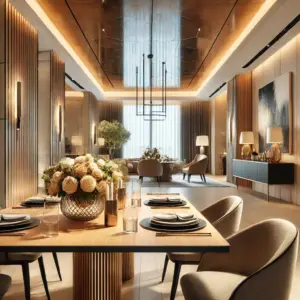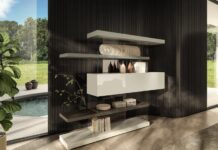The quest for the ideal table top can be both exhilarating and daunting. It is not simply about choosing a surface to dine or work on; it involves making a decision that impacts the aesthetics and functionality of an interior space. Those who have the discerning eye for design know that a table top is the centrepiece of room decor, dictating style and influencing the ambience of an environment.
Understanding the Significance of a Table Top
A table top is not just a practical necessity; it is a defining feature of an interior space. It’s the stage upon which life unfolds – from family meals to bustling gatherings, or the silent companion during hours of diligent work. Thus, selecting the right one is critical for any interior design endeavour.
Assessing Your Space
Before commencing the search for the perfect table top, it is essential to thoroughly assess the space it will occupy. The size and shape of the room, the existing decor, lighting, and intended use all play crucial roles in the decision-making process. Moreover, the table must accommodate the required seating while allowing for adequate movement around the room.
Material Matters
The material of a table top is a cornerstone to its appeal and longevity. Each material offers distinct advantages, textures, and colours that contribute to the overall design narrative. From classic wood that exudes warmth to modern glass that reflects light and creates a sense of openness, the choices are plentiful.
Durability is also a significant consideration. A family kitchen table, for instance, might benefit from a hardy, easy-to-clean surface such as laminate or granite. Meanwhile, a conference room in a corporate setting may call for the sophistication of polished stone or the professionalism of quality wood.
Colour and Texture Interplay
The colour and texture of a table top must seamlessly integrate with the room’s existing palette and design elements. A stark white table can stand out in a dark-toned room, making a bold modern statement, while a richly grained wooden table might add a sense of organic charm to a minimalist space.
Textures can also influence the perception of space. A glossy finish can reflect light and brighten up a room, whereas a matte or rustic finish might invoke a cosy, intimate vibe.
Form Reflects Function
Consider how the table will be used. For a household that entertains frequently, a larger table that can accommodate guests may be necessary. A creative professional, on the other hand, might prefer a table top with ample space for spreading out materials and tools.
The shape is another component to consider. Circular tables foster a convivial atmosphere perfect for social interactions, whereas rectangular tables offer structured alignment more suitable for formal settings.
Balance with the Base
The relationship between a table top and its base is a dance of aesthetics and engineering. While the top captures attention with its colour and material, the base must support it both structurally and stylistically. Ensuring that the base is proportionate and complementary to the top is key to the table’s overall appeal and stability.
Bespoke Designs
Customisation is a splendid option for those seeking a unique table top tailored to individual preferences. Bespoke designs permit a mix of materials, innovative shapes, and personalised details that can make a table top distinctly one’s own.
The Ecological Perspective
In today’s eco-conscious world, the sustainability of a table top is increasingly important. Consider the provenance of the materials, the manufacturing process, and the longevity of the design. Opting for sustainably sourced wood, recycled materials, or local craftsmanship can reduce environmental impact while adding a positive narrative to your space.
Visual Continuity
When integrating a new table top into an existing design scheme, it is paramount to maintain visual continuity. The table should not just match but also enhance the room’s decor. This can mean aligning with the geometric patterns of the surrounding furniture or echoing the architectural lines of the space.
The Tactile Experience
A table top is experienced not just visually but also through touch. The texture of the surface under the fingertips – whether it is the smooth coolness of marble or the natural warmth of wood – adds to the sensory experience of the space.
Light Refraction and Absorption
Light plays a pivotal role in interior design, and the choice of table top can greatly affect how light is absorbed or reflected in a room. A mirrored or glass table top can brighten a space by reflecting light, whereas a dark wooden table may absorb light, creating a more subdued atmosphere.
Statement Making
A table top can serve as a focal point in room design, making a statement that draws the eye and anchors the space. Whether through an unusual material, an intricate design, or a bold colour, a statement table can serve as an art piece as much as a functional element.
Investing Wisely
A high-quality table top is an investment in the beauty and functionality of a space. Therefore, consider your choice a long-term investment and opt for materials and construction that will stand the test of time.
Conclusion
Selecting the perfect table top requires a harmonious blend of aesthetic design, practicality, and a thoughtful consideration of the space it will inhabit. Whether one opts for a traditional, classic design or seeks a more modern, custom piece, the quest for the right table top should always be pursued with both passion and precision. Explore the collections, such as the one offered by Shop for Shops, to find a table top that raises the bar for interior design.








